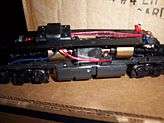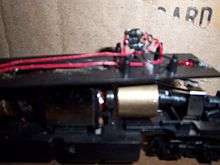Proto 2000 BL2
The Proto 2000 BL2 is an HO scale model of the EMD BL2 introduced by Life-Like Trains in 1989, the first in their series of higher-quality Proto 2000 products.

The released made a big impact on the hobby of model railroading, as it was the first serious attempt by a manufacturer to mass-produce an accurate ready-to-run model of the rare EMD diesel locomotive.[1]
Shell versions
Like most Proto 2000 models, this locomotive had two variations. Both came in boxes that had the frame with the drive line separated form the body shell, each in its own compartment. The shell was almost the same on both. It was the proper width had the steps on the doors as well as all grab irons with vibrant paint. The main differences were that the mark I version had sunshades that attach with a cured looking bar. These shells, like the rest of the shells on these locomotives, set a new standard for detailing.
First drive version

The first versions (Mark I) came in an olive green box. While almost identical to the latter version in terms of its shell, the drive train, consisting of the motor, shafts, gears, etc., was a direct copy of the Athearn blue box system. It featured the big trademark flywheel and a standard Athearn motor that was isolated from the frame. One of the few exceptions was the drive wheels. Life-Like made use of its trademark and rather infamous brass wheels for these early models instead of the steel wheels like the Athearn blue box models. These models also had the almost iconic metal hooks on the trucks. These hooks were used on the Atheran blue box models, to contact the top of the motor for the positive current. For the Proto 2000 model, wires from the motor and lights were soldered to the metal contact line. The contact provided the positive power to the motor and lights. A plastic shelf mounted on top of the motor that ran the length of the locomotive provided a place to mount the directional headlights and the crew figures at the front at the right height. Like all early Proto 2000's and all blue box Athearns, this version of this locomotive used the frame as its negative power source which was intern grounded by the trucks to the track. The fact that the motor was isolated from the frame and the lights were stranded bulbs and directional made the Athearn contact, wire free, system impossible to use. To make the locomotive function, with this kind of setup, Life-Like sent all of the negative connections from the head lights and the motor to one location, a box on the shelf on the opposite end where the crew were positioned at the rear of the locomotive. This box contained three diodes linked together. Each negative hookup was connected to its own diode. These diodes were, intern, linked by a wire to a connection with the frame. The diodes connected to the head lights were wired to only work when the current received went one way so that one headlight would work in one direction at a time. These locomotives also employed an unusual coupler pocket system borrowed and modified from the Athearn blue box models: a simple plastic cover that was pressed down into position. While this system made attaching the standard horn hook couplers simple, they fell off just as easily.
Second drive version

The second release of the Proto 2000 BL2 came in a Blue-Green box. They featured an updated motor that was also insulated from the frame with better, cut down flywheels. They also featured more traditional kadee type coupler pockets and no-spring knuckle couplers that were based on Kadee couplers. The drive wheels were now updated to nickel silver, vastly improving power pickup. These units were also equipped with a DCC-ready socket from the factory making DCC conversion easy. The dummy plug board that was installed by the factory allowed the locomotive to run with stranded direct current control and replaced the complex wiring for the directional headlights.
Reliability issues
Like most of the Proto 2000 locomotives, both versions of these models were plague by mechanical problems. One problem was that grease was used far in excess of what was necessary by the factory. It was also of very poor quality and would harden quickly if the locomotive was stored in a dry environment. This would cause the trucks and worm gear shaft to seize, jamming the drive-train and rendering the locomotive inoperative. Repairs would normally require the locomotive to be completely disassembled and de-greased, then re-lucubrated to get the drives back in running order.
One advantage that the drive on the BL2 locomotives model had was that the trucks and worm gears covers were exposed. This made it easy to handle the above described problems. On latter models, these parts were encased in a massive weight which had to be removed. Getting this weight out required several screws to be removed, some hidden under the fuel tank. The weight also guided the wires around the locomotive. This made disassembling the locomotive for maintenance difficult and frustrating.
The biggest problem that plagued these models was cracked or split gears on the wheel sets. These would make an annoying "thumping" sound as the locomotive rolled along and could jam or lead to damage to the rest of the drive train, if not replaced.
References
- "HO-Scale Trains Resource - The Original Database of Vintage HO Scale Model Trains". HO-Scale Trains Resource. Retrieved 2018-03-12.